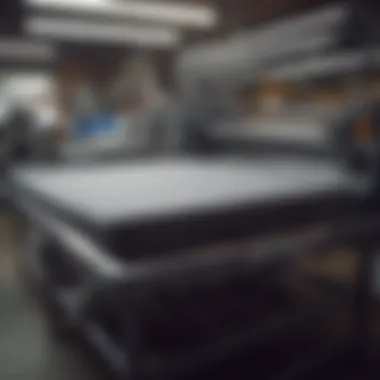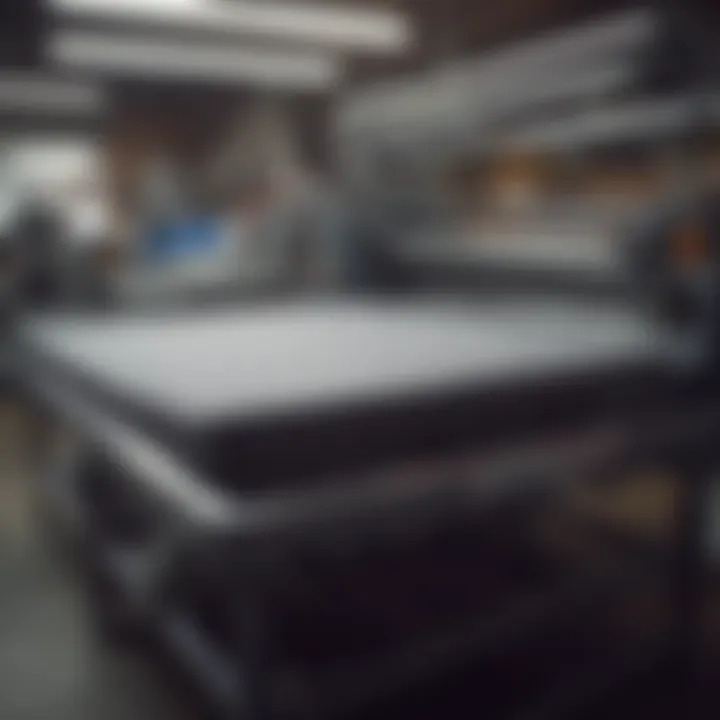Starting Your T-Shirt Press Business: A Complete Guide


Intro
Starting a t-shirt press business can prove to be a rewarding venture for those willing to invest time and effort. The process involves understanding various elements from market dynamics, customer preferences, to production techniques. It is essential to follow a structured approach.
Market Overview
In today's ever-evolving landscape of custom apparel, understanding the market is crucial for success. The t-shirt printing sector has witnessed significant growth in recent years, fueled by the rise of e-commerce and personalization trends.
Current Market Sentiment
Currently, the sentiment is positive. As consumers seek unique and personalized clothing, demand for custom t-shirts continues to rise. Businesses that cater to niche markets, such as local events or specific communities, often find themselves ahead.
Major Indices Performance
The performance of major apparel-related indices reflects this growth. Companies involved in custom apparel have seen fluctuations, but the overall trend remains upward. Monitoring these indices can guide entrepreneurs in understanding market shifts.
Economic Indicators Analysis
Economic indicators, such as consumer spending growth and employment rates, directly impact the t-shirt press industry. A stable economic environment boosts disposable income, allowing people to spend more on custom clothing. In addition, the impact of e-commerce growth cannot be overstated, as many consumers prefer to shop online.
Business Planning
Establishing a solid business plan is essential. This involves defining a clear vision, setting realistic goals, and conducting detailed market research. A well-structured business plan will serve as a roadmap for various stages of your venture.
Identifying Your Niche
Understanding your target market is vital. Investigate various segments such as local businesses, schools, or non-profit organizations that may require custom printed apparel.
Financial Considerations
Budgeting adequately is crucial. Factor in costs like equipment, raw materials, marketing, and operational expenses. Having a clear understanding of your finances can help reduce unexpected challenges down the line.
Equipment Selection
Choosing the right equipment can make or break your business. Start with essential tools like a heat press machine, a quality printer, and software to create designs. Research brands like Roland, Epson, and Cricut, known for reliability in the printing industry.
Marketing Strategies
Once the groundwork is laid, effective marketing is key. Utilize social media platforms such as Facebook and Instagram to create awareness. Offering promotions and discounts can attract initial customers while ensuring quality will encourage repeat business.
Customer Satisfaction
Ensuring customer satisfaction should remain a priority. This includes providing excellent service, maintaining quality in products, and resolving issues promptly. Happy customers often lead to referrals, which can significantly boost your brand visibility.
Successful businesses understand their customers' needs and adapt accordingly.
Closure
Prelims to T-Shirt Press Business
The t-shirt press business stands as a prominent avenue for entrepreneurs seeking to blend creativity and commerce. As a garment that transcends demographics and cultures, the t-shirt holds a unique position in fashion and marketing. This section emphasizes the significance of understanding the t-shirt press industry, its potential, and how one can capitalize on it.
The t-shirt business is not solely about selling apparel. It includes the design, production, and marketing aspects that contribute to its success. A well-informed entrepreneur can tap into the vast possibilities that this industry presents, from custom designs to mass production. Moreover, with the rise of e-commerce, the accessibility and scalability of a t-shirt press business have increased.
Understanding the Industry
To successfully navigate the t-shirt press domain, it is crucial to grasp the industry's fundamentals. This includes knowing the various printing techniques such as screen printing, direct-to-garment, and heat transfer methods. Each technique offers distinct benefits and limitations, influencing costs and production times. For instance, screen printing is traditionally favored for large orders due to its efficiency, while direct-to-garment is often selected for intricate, multicolored designs on smaller runs.
Additionally, factors that determined market trends must be closely monitored. Consumer preferences shift, and staying updated on these changes can help a newcomer make informed decisions. Understanding seasonal demands and popular styles enhances the ability to create products that resonate with the target audience. The industry has also seen a growing interest in sustainability, driving a shift towards eco-friendly materials and practices.
Key Players in the Market
No industry is devoid of competition, and the t-shirt press business is no exception. Recognizing key players provides insights into market dynamics. Major brands, independent designers, and local shops all contribute to the vast landscape. Companies like Custom Ink and Printful have carved out significant spaces for themselves by offering customized services and easy-to-use platforms.
In addition, collaborations between brands and artists have surged, demonstrating how partnerships can effectively widen reach. This aspect of the industry showcases the importance of networking and establishing partnerships.
Moreover, analyzing consumer feedback and buying patterns can reveal gaps in the market where new entrants can innovate.
In summary, gaining a thorough understanding of the t-shirt press industry and identifying key players creates a groundwork for aspiring entrepreneurs. It acts as a compass, directing efforts towards thriving in this competitive field.
Market Research
Conducting thorough market research is essential for anyone looking to establish a t-shirt press business. This process provides valuable insights into industry dynamics, customer preferences, and competitive landscapes. Understanding the market can help guide decisions, minimize risks, and ultimately contribute to the overall success of the business.
Identifying Target Audience
Identifying your target audience is the foundation of effective marketing strategies. Knowing who your customers are will help shape your product offerings, branding, and promotional activities. You may segment your audience based on factors like age, gender, interests, and geographical location.
For example, if you focus on graphic tees for younger audiences, your designs and marketing tone may differ compared to targeting a more mature audience. Utilize surveys and social media insights to gather data about potential customers.
Some key factors to consider include:
- Age range and gender preferences
- Interests and hobbies
- Shopping habits and preferences
By understanding these elements, you can tailer your designs and marketing messages to resonate with your audience, increasing engagement and sales.
Analyzing Competitors
Analyzing competitors is another critical component of market research. Assessing other t-shirt press businesses will provide insights into their strengths and weaknesses. Identify who your main competitors are, along with their pricing strategies, designs, and customer engagement methods.


Tools like SWOT analysis can be helpful here:
- Strengths: What do they do well?
- Weaknesses: Where can you outperform them?
- Opportunities: Are there gaps in their offerings?
- Threats: What challenges do they present to your business?
By strategically evaluating these aspects, you can position your t-shirt press business more effectively in the market.
Trends in T-Shirt Design
Staying updated on trends in t-shirt design is vital for maintaining competitiveness. Design trends can shift quickly based on cultural, technological, and societal influences. Whether it’s a resurgence of vintage graphic tees or a rise in eco-friendly fabric choices, being attuned to these trends can guide your product development.
Keep an eye on social media platforms like Instagram or Pinterest for emerging design trends. Additionally, monitoring platforms such as Reddit can provide insights on what consumers are currently interested in.
Some aspects to consider include:
- Color schemes: What colors are popular at the moment?
- Graphic styles: Is minimalism trending, or is bold graphic art back in fashion?
- Material preferences: Are customers demanding more sustainable or organic materials?
By integrating these trends into your offerings, your business can stay relevant and appealing to your target audience.
In summary, thorough market research enables aspiring entrepreneurs to make informed decisions, tailoring their business models to effectively meet the needs and preferences of their potential customers.
Business Planning
Business planning is a cornerstone of any successful operation, particularly in the t-shirt press business. It is not merely a chore to tick off; rather, it serves as a strategic roadmap guiding every aspect of your venture. Without a well-conceived plan, one risks misallocating resources, misjudging market demand, and ultimately jeopardizing the business’s future.
A robust business plan typically includes components such as market analysis, financial projections, product specifications, and operational strategies. Notably, engaging in this level of detail helps to clarify your vision and objectives. Entrepreneurs can also identify potential risks before they evolve into larger issues. By thoroughly addressing each of these elements, you cultivate a stronger foundation on which to build your business.
Creating a Business Model
Creating a functional business model is pivotal for your t-shirt press endeavor. It encapsulates your value proposition, revenue streams, and customer segments. Start by determining what sets your offering apart. Are you focusing on custom designs, eco-friendly materials, or perhaps a niche market like sports apparel?
Consider these key components when designing your business model:
- Value Proposition: What unique value do you bring to the table? Think about customer pain points you're solving.
- Revenue Streams: Identify where your income will come from. Direct sales, online platforms, or wholesale partnerships are all possibilities.
- Customer Segments: Define your target audience meticulously. Are they teenagers, professionals, or businesses?
The completed model acts like a compass. It points in the direction of your goals while informing your business decisions as you navigate the complexities of the industry.
Setting Up Financial Projections
Setting up financial projections is critical to the sustainability of your t-shirt press business. This typically involves preparing three key financial statements: the income statement, cash flow statement, and balance sheet. These documents collectively provide insight into your expected business performance over a specific period, usually three to five years.
Financial projections should address several essential areas:
- Startup Costs: Initial investment can be high in the t-shirt press industry. Calculate expenses for equipment, materials, and marketing, to name a few.
- Sales Forecasts: Analyze market demand to estimate how many t-shirts you expect to sell. This helps in planning inventory and production schedules.
- Break-Even Analysis: Understand how long it will take to cover your initial investment. Knowing your break-even point is vital for financial health.
Utilizing financial software can streamline your projections and improve accuracy. Regularly updating these forecasts as actual performance data comes in will ensure your plans remain relevant.
Planning is bringing the future into the present so that you can do something about it now.
Selecting Equipment
Choosing the right equipment is essential when starting a t-shirt press business. The equipment significantly influences the quality of the final product, production efficiency, and overall profitability. It is crucial to carefully assess your needs before making any purchasing decisions. The right machinery ensures you can meet customer demands while maintaining high standards of quality.
Types of T-Shirt Press Machines
When selecting a t-shirt press machine, you will encounter various types, each catering to different production needs. Understanding the distinctions helps in making informed choices. Here are some common types:
- Clamshell Heat Press: This is one of the most widely used heat press machines. It operates like a clamshell, with a top plate that swings down to meet the bottom plate. It is ideal for small businesses due to its affordability and compact design.
- Swing Away Heat Press: Unlike clamshell machines, the swing away model allows the top plate to swing to the side, providing easy access to the items being pressed. This feature minimizes the risk of burns and increases efficiency in production.
- Draw Heat Press: This type has a pull-out drawer feature that allows for easy loading and unloading. It is beneficial for users who print on various sizes of garments and need more space during operation.
- Cap Heat Press: Specifically designed for caps and hats, this machine has a unique shape that matches the curvature of hats, allowing for effective printing.
Each machine type comes with its benefits and potential drawbacks. It is advisable to consider your production volume, workspace, and budget before making a decision.
Necessary Accessories and Supplies
In addition to the press machine, several accessories and supplies are indispensable for successful operations. These items help maintain efficiency and quality during the printing process. Consider stocking up on the following:
- Transfer Paper: This is a critical component in the heat press process. Using the right transfer paper is essential for achieving high-quality prints.
- Teflon Sheets: These sheets protect both the press plates and the garments from sticking together during the heat transfer process.
- Weeding Tools: For vinyl projects, weeding tools help to remove the excess material from the design before pressing.
- Protective Equipment: Heat-resistant gloves and aprons can provide safety benefits in a working environment, reducing the chances of burns or accidents.
- Storage Solutions: Organizing supplies and accessories ensures quick access and efficiency during production.
Designing T-Shirts
Designing t-shirts is a critical component of establishing a successful t-shirt press business. It is not merely about picking colors or fonts; it's about creating visual identities that resonate with consumers. The design will determine whether the shirt becomes a sought-after item or is quickly forgotten.
A well-designed t-shirt can serve various purposes. It can reflect personal beliefs, promote businesses, or simply represent a style. Thus, making design decisions that align with market trends and customer preferences is essential. More importantly, effective t-shirt designs can stimulate conversation and build communities around shared interests.
Aspects to consider in t-shirt design include:
- Target Audience: Understanding who will wear the shirts is vital. Age, style preferences, and social trends all play a significant role.
- Quality of the Design: High-quality graphics and clear messaging will attract potential buyers. The clarity and appeal of the design enhance its desirability.
- Versatility: Successful designs should appeal to a wide array of occasions and be adaptable to various styles.
Ultimately, effective t-shirt design combines creativity, market research, and awareness of current trends. This balance will significantly enhance a brand's identity and customer engagement.
Collaborating with Designers
Collaborating with designers can elevate the quality of your t-shirt designs significantly. Designers often bring professional expertise, a fresh perspective, and experience that can transform basic ideas into remarkable works of art. The collaboration process begins with clear communication regarding your vision and goals.
Here are some benefit of collaboration:
- Creative Vision: Designers can take your initial idea and expand upon it. They may produce concepts you haven't considered that enhance overall appeal.
- Expertise: Professional designers understand design principles, color theory, and market preferences, which are key to producing standout apparel.
- Efficiency: Collaborating allows for faster turnaround times. Designers are typically more adept at software and tools necessary for creating high-quality designs.
However, it is important to establish a clear contract before beginning collaboration. Outlining ownership rights, payment structures, and deadlines will help avoid misunderstandings.
Using Design Software
Using design software is another important skill for t-shirt press entrepreneurs. With the right tools, you can create, modify, and perfect your designs before they go into production. Familiarity with design software like Adobe Illustrator or CorelDRAW is advantageous.


Key Features of Design Software include:
- Vector Graphics: Most professional software supports vector graphics, allowing designs to be scaled without losing quality. This is crucial for printing.
- Templates: Many programs offer templates that can simplify the design process, especially for beginners.
- Color Accuracy: Digital software lets you experiment with colors accurately, giving a real sense of how the final product will appear.
Despite the learning curve involved, investing time in mastering design software is worthwhile. The capacity to create customized designs in-house can lead to both creative control and cost savings.
Remember, a well-designed t-shirt is more than just fabric; it’s a canvas that tells a story, reflects culture, and often embodies a cause.
Production Process
The production process plays a pivotal role in a successful t-shirt press business. This process encompasses the transformation of raw materials into a finished product that meets customer expectations. Efficiency in production directly correlates to profitability. If the workflow is streamlined, costs can be minimized while maintaining high product quality. This section elaborates on the specific components that comprise an effective production process.
Step-by-Step Production Workflow
A well-defined production workflow is essential for the operational success of a t-shirt press business. Each step should be meticulously planned to ensure optimal efficiency. Here’s a breakdown of the typical stages in the production workflow:
- Design Phase: Begin with the creation of the t-shirt design, ensuring it resonates with your target audience.
- Material Sourcing: Source high-quality fabrics and inks that align with the desired output. This affects both quality and durability.
- Pre-Press Preparation: Prepare the graphics for printing. This may involve adjusting colors and resolution to match specifications.
- Press Setup: Configure the press machine for the specific order. Adjust settings like temperature and pressure according to material needs.
- Printing: Execute the printing process carefully. Each shirt must be checked for alignment and consistency.
- Post-Production: After printing, the shirts may require curing, washing, or other processes to enhance quality.
- Quality Inspection: Conduct a thorough inspection of the shirts to identify any defects before packing.
- Packaging and Shipping: Finally, package the finished products properly for delivery without damage.
Adhering to this workflow reduces the chance of errors and increases overall efficiency in your operations.
Quality Control Strategies
Maintaining product quality is non-negotiable for fostering customer satisfaction and loyalty. Quality control strategies should be integrated throughout the production process. Here are some effective measures:
- Standard Operating Procedures (SOPs): Develop and maintain SOPs for each step of the production workflow. This ensures consistency in quality and performance.
- Regular Equipment Maintenance: Schedule regular checks and maintenance of equipment to prevent malfunctions which can lead to poor prints.
- Sampling and Testing: Before full production, conduct tests with samples. This allows for adjustments in design or material before a large batch is produced.
- Employee Training: Ensure all staff are well-trained in quality standards and production techniques. A knowledgeable team can identify issues before they manifest in the final product.
Quality in production not only enhances customer satisfaction but also improves brand reputation and business sustainability.
Marketing and Promotion
Marketing and promotion are critical elements in establishing a successful t-shirt press business. Without effective marketing strategies, even the best designs may go unnoticed. It connects your products to potential customers. This connection facilitates brand visibility and drives sales, ultimately contributing to the sustainability of the business. Here, we will explore pivotal aspects such as establishing an online presence, utilizing social media platforms, and implementing effective pricing strategies.
Establishing an Online Presence
Creating a strong online presence is essential for any t-shirt press business. A professional website serves as the digital storefront, showcasing products and providing critical information. To establish a solid foundation, consider the following:
- Domain Name: Choose a memorable domain name that reflects your brand. It should be easy to spell and recall.
- E-commerce Platform: Select an e-commerce platform to sell products. Shopify or WooCommerce are popular choices, allowing you to manage inventory and transactions efficiently.
- Content Optimization: Use SEO practices to optimize your website for search engines. Include relevant keywords related to t-shirt designs and printing services to attract organic traffic.
Developing a user-friendly layout enhances the experience, making it easy for customers to navigate. Overall, an optimized online presence builds credibility and encourages customers to engage with your brand.
Utilizing Social Media Platforms
Social media platforms offer unique opportunities for marketing by allowing direct engagement with customers. To maximize this approach, focus on:
- Choosing Platforms: Identify which platforms align with your target audience. Instagram is visually-driven, making it perfect for showcasing t-shirt designs. Facebook is useful for community engagement.
- Content Creation: Post regularly with a mix of product showcases, behind-the-scenes content, and customer testimonials. Engaging content fosters relationships.
- Using Ads: Invest in targeted ads to reach specific demographics. Facebook and Instagram ads offer powerful tools to refine audience targeting.
Engaging with the audience through comments or messages further strengthens customer relationships. This can also lead to brand loyalty, driving repeat business.
Effective Pricing Strategies
Pricing strategies impact sales and brand perception. Consider the following factors to develop a successful pricing strategy:
- Cost Calculation: Understand your costs. Calculate the production cost, including materials, labor, and overhead. This sets a baseline for pricing.
- Market Analysis: Research competitors' prices to position your offerings. Ensure your prices are competitive but reflect the quality of your products.
- Promotional Offers: Introduce sales or discounts to attract new customers, especially during holidays or special events. Limited-time offers create urgency and encourage purchases.
Regular review of pricing strategies is necessary to adapt to market changes or shifts in customer expectations. Adjustments may be required to stay relevant and competitive.
Sales Channels
Sales channels represent a crucial aspect of establishing a successful t-shirt press business. They are the avenues through which you sell your products. Choosing the right sales channels can significantly impact your revenue and overall business sustainability. Direct-to-consumer and partnerships with retailers are two important channels that require careful consideration. Successful navigation of these channels can lead to increased brand awareness and customer loyalty.
Direct-to-Consumer Sales
Direct-to-consumer sales involve selling your t-shirts straight to the end customer. This model eliminates intermediaries and often results in higher profit margins. The key benefits include:
- Control Over Branding: You can showcase your brand exactly how you want without any distortion from third parties.
- Customer Relationships: Engaging with customers directly allows you to build long-lasting relationships. You understand their preferences better and can tailor your offerings according to their needs.
- Increased Profits: By selling directly, you keep most of the revenue that would otherwise go to a retailer.
However, this method does come with challenges. You are responsible for marketing, fulfillment, and customer service. Establishing a robust online store is essential. You can utilize platforms such as Shopify or WooCommerce to set up a professional site easily. Additionally, consider investing in online advertising campaigns to drive traffic.
Partnering with Retailers
Partnering with retailers offers a different strategy for selling your t-shirts. This approach involves selling your product through established stores. Some advantages include:
- Wider Reach: Retailers often have an established customer base that can expose your product to a larger audience.
- Reduced Marketing Burden: Retailers will typically handle some marketing and promotion, easing your workload.
- Credibility: Being present in a reputable store can lend credibility to your brand.
Still, working with retailers has its drawbacks. Retailers may take a significant cut of your profits and may not present your brand as you wish. Therefore, it is crucial to select retailers that align with your brand's values and target demographic. Establish clear terms regarding pricing, marketing, and presentation to minimize complications.
Financial Management
Financial management is a critical aspect of operating a successful t-shirt press business. It encompasses the planning, organizing, directing, and controlling of financial activities. Proper financial management allows business owners to make informed decisions, ensuring the long-term sustainability and growth of the company.
Key elements of financial management in this context include:
- Budgeting: Establishing a sound budget is essential. It helps to track expenses and revenues, allowing for better forecasting.
- Cash Flow Management: Monitoring cash flow is vital for daily operations. A positive cash flow ensures that the business can meet its obligations without delay.
- Profit Analysis: Understanding profit margins on each t-shirt sold aids in setting competitive yet sustainable prices.
- Investment Strategy: Knowing where to allocate resources, whether in equipment or marketing, can significantly impact growth.
The benefits of effective financial management are significant. It enables entrepreneurs to:
- Identify Weaknesses: By comparing projected budgets to actual performance, it is easier to identify areas needing improvement.
- Enhance Profitability: With accurate financial tracking, adjustments can be made to increase profits.
- Facilitate Growth: A clear financial picture can indicate when and how to expand operations.
In summary, financial management is not just about keeping track of money. It is about making strategic decisions that enhance the overall operational effectiveness of the t-shirt press business.
Tracking Revenue and Expenses


Tracking revenue and expenses is foundational to sound financial management. Without comprehensive tracking, it becomes difficult to understand the financial health of the business. Each t-shirt sale should be logged, along with the costs of materials and labor involved in production.
Tools for Tracking
Using accounting software can streamline this process. Programs like QuickBooks or Xero offer user-friendly interfaces that can automate many functions, which reduces manual entry errors. It is crucial to:
- Regularly update records to maintain accuracy.
- Reconcile monthly statements to ensure all transactions are accounted for.
Effective tracking provides insights into profit margins per product line. This information can drive pricing strategies and assist in identifying popular products or designs.
Navigating Taxes and Legal Requirements
Understanding taxes and legal requirements is vital for any small business. The t-shirt press business is no exception. Different regions have different tax obligations, and it is essential to stay compliant with local, state, and federal regulations.
Essential Considerations
- Sales Tax: Many jurisdictions require businesses to collect sales tax on items sold. Understanding the intricacies can prevent costly penalties.
- Business Licenses: Ensuring all necessary licenses are obtained will protect the business from legal issues.
- Tax Deductions: Familiarity with available deductions can significantly reduce tax liability. This includes costs related to equipment, materials, and marketing.
Consulting with a tax professional can provide guidance tailored to your business needs.
Staying informed about changes in tax law and compliance standards is crucial. Engaging a tax advisor regularly can help ensure adherence and optimize the t-shirt press business’s financial management.
Customer Service
Customer service is a crucial aspect of any business, and it holds special importance in the t-shirt press industry. The way a business interacts with its customers can significantly impact its reputation, customer loyalty, and overall success. Providing outstanding customer service not only enhances the experience for customers but also helps in retaining them, which is essential for sustaining a profitable business.
Good customer service can lead to multiple benefits. Firstly, it fosters customer loyalty. When clients feel valued and appreciated, they are more likely to return for future purchases. Secondly, it can create a positive brand image. Word of mouth is powerful; satisfied customers can promote your brand to others, enhancing visibility and driving new business. Moreover, handling customer inquiries and complaints effectively can result in increased sales, as satisfied customers often make repeat purchases or refer others.
In addition, the t-shirt press business operates in an environment where trends change rapidly, and customer preferences can evolve quickly. Timely and attentive customer service can help businesses gauge these changes. Listening to customers can provide valuable insights into their needs and preferences, allowing businesses to adjust their offerings accordingly. This adaptability can set a business apart from its competitors.
Building Customer Relationships
Building strong relationships with customers is foundational for any thriving t-shirt press business. Trust is the bedrock of these relationships. For many, a t-shirt is more than just clothing; it often carries personal significance. To build trust, businesses must maintain transparency and consistency in their products and services.
Several strategies can enhance customer relationships:
- Personalization: Tailoring communication and offers based on customer preferences makes them feel special.
- Engagement: Regularly connecting through newsletters, social media, or updates keeps customers informed and involved.
- Trustworthiness: Make sure to deliver quality products consistently. Meeting, or even exceeding, customer expectations cements loyalty.
It's vital for the business to understand that, in today’s digital age, customer relationships extend beyond one-time transactions. They encompass ongoing interaction and communication. Hence, taking time to build rapport can yield long-term benefits.
Managing Customer Feedback
An effective approach to managing customer feedback is indispensable in the t-shirt press business. Feedback serves as a mirror reflecting customer satisfaction and areas needing improvement. Properly managing this feedback can enhance products, services, and customer experiences.
To effectively manage customer feedback:
- Encourage Open Communication: Provide channels for customers to voice their opinions, opinions, and suggestions. This may include surveys, emails, or social media platforms.
- Act on Feedback: Show customers that their thoughts matter by implementing their suggestions when possible. This demonstrates commitment to improvement.
- Follow Up: After addressing feedback, follow up with the customer to inform them of the changes made. It reassures them their opinions have been taken seriously.
- Respond Promptly: Quick responses to inquiries or complaints show respect for the customer’s time and concerns.
Listening to customers offers a profound advantage over competitors, as it nurtures loyalty and ensures their satisfaction.
Challenges and Solutions
Understanding the challenges in the t-shirt press business is fundamental to achieving success. Every entrepreneur encounters obstacles as they seek to establish and grow their venture. Acknowledging these challenges allows for proactive planning and effective strategies to mitigate risks. Additionally, navigating solutions unveils opportunities to optimize operations, enhance customer satisfaction, and improve profitability. This section addresses the common challenges faced and presents strategic solutions tailored for success in the t-shirt press industry.
Common Challenges Faced
Starting a t-shirt press business is not without its hurdles. Many entrepreneurs may find themselves grappling with a variety of issues, including:
- Market Saturation: With so many players in the market, differentiating one's brand can be difficult. Identifying a unique selling proposition is essential.
- Equipment Costs: High-quality printing equipment often requires a significant upfront investment. This can strain initial finances, especially for new proprietors.
- Quality Control: Maintaining consistent product quality is crucial. Misprints or defective items could lead to customer dissatisfaction and harm the brand’s reputation.
- Supply Chain Management: Managing inventory and suppliers can become complex. Delays or shortages in raw materials could disrupt the production process.
- Customer Acquisition: Acquiring new customers poses a challenge. Compelling marketing strategies are necessary to attract attention in a crowded market.
Strategic Solutions
Each challenge offers an avenue for innovative solutions. Here are effective strategies that can alleviate these challenges:
- Niche Identification: Focus on a specific niche within the t-shirt market. This helps limit competition and demonstrates expertise in a particular area. For example, targeting eco-conscious consumers or graphic art enthusiasts can set the business apart.
- Financing Options: Consider leasing equipment or applying for business loans. This can help manage initial costs while allowing the business to grow and establish a steady cash flow.
- Quality Assurance Processes: Implement stringent quality control protocols. Regular checks during production can catch errors early, minimizing waste and ensuring consistency. Training team members on these processes fosters a quality-centric culture.
- Supply Chain Optimization: Build strong relationships with suppliers and diversify sources. This reduces dependency on a single supplier and ensures that alternative options are available in case of delays.
- Robust Marketing Plans: Create effective marketing campaigns using social media, targeted ads, and collaborations with local influencers. This approach increases visibility and can lead to stronger customer engagement. Consider platforms such as Facebook and Reddit to reach wider audiences.
Successful entrepreneurs view challenges not as roadblocks but as opportunities to innovate and improve.
Addressing challenges head-on allows for continuous improvement in operations and strategy. When faced with difficulty, persistent effort combined with strategic solutions can pave the way for long-term success in the t-shirt press business.
Future Trends
Understanding future trends in the t-shirt press business is crucial for maintaining a competitive edge. As markets evolve, so do consumer expectations, technology, and sustainability practices. Keeping an eye on these trends helps businesses adapt and thrive in a dynamic environment.
Adopting sustainable practices can lead to long-term benefits. Not only does it appeal to environmentally-conscious consumers, but it also helps reduce operational costs. Businesses need to think about the materials they use, the processes they implement, and how they can minimize waste.
Sustainability Considerations
Sustainability in the t-shirt press industry is becoming increasingly important. Consumers are more aware of the environmental impact of their purchases. They prefer brands that prioritize eco-friendly materials and processes. Businesses can benefit from this shift by adopting sustainable practices.
Practices to consider include:
- Using organic fabrics: Materials such as organic cotton reduce pesticide use and are kinder to the planet.
- Implementing water-saving techniques: Many printing processes consume significant amounts of water. Finding ways to minimize usage is essential.
- Adopting energy-efficient machinery: Investing in machines that use less energy can lower operational costs and reduce the carbon footprint.
A commitment to sustainability can enhance a brand's image and lead to greater customer loyalty.
Emerging Technologies in Print
Emerging technologies are reshaping the t-shirt printing landscape. Staying updated on these advancements is vital for competitiveness. New techniques allow for greater customization and efficiency.
Some notable technologies to watch include:
- Direct-to-Garment (DTG) Printing: This method allows for high-quality designs and is suitable for small runs. The process is efficient and allows for intricate designs without excess waste.
- Digital Printing: Digital printing offers flexibility and speed. It can produce detailed graphics on demand, which is ideal for meeting customer preferences.
- 3D Printing: Although still in early stages for textiles, this technology can revolutionize how designs are created and applied.
Embracing these technologies will not only enhance production capabilities but also cater to the evolving demands of consumers who seek unique and customizable products.
As the industry moves forward, those who embrace both sustainability and technological advancements will likely find themselves at the forefront of the market.



